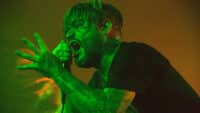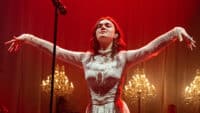Music

WTF is...?
WTF is… Midwest emo?
Next in our series of niche deep dives is this raw, twinkly and emotionally wrought sub-genre
Mention the word “emo” among friends and you’re likely to get either a knowing nod, a cringing wince, a vacant stare or something resembling concern. To the pragmatic, it’s a handy catch-all term that sweeps broadly across forty-odd years of rock music. To the pedantic, it’s something sacred that has long been misused, misunderstood and misshaped into a kind of lazy free-for all, tainted by brush-back hair and black eyeliner.
Both would be correct, in that as a music genre (let’s forget your sartorial choices from 2005 for now) emo or emotional rock has developed and moved across different phases or waves – more on that later. But it’s also true that many consider its ideal form to be Midwest emo, a scene that spawned in the 90s in the likes of Illinois, Indiana and Michigan. Its birthplace gave the genre its name, but its sound would ultimately define it, with many of its most notable champions coming from far and wide.
This sub-genre seems to have found its way back into popular culture lately. It’s a clear influence on indie darlings like Alex G, Pinegrove and Phoebe Bridgers. Memes show guitarists playing Midwest emo intros over videos of people shouting, monologuing or just generally having a breakdown. Others are dedicated purely to American Football’s ‘Never Meant’ – surely the genre’s quintessential song – be that through the medium of dancing or medieval lute renditions. Heck, American Football are even supporting The 1975 in Finsbury Park this summer.
Still scratching your head? Let’s take a closer look.
Early stages
Midwest is often referred to as the second wave of emo. The first is attributed to 1980s Washington D.C., where as part of the Revolution Summer of 1985 bands such as Beefeater and The Rites of Spring rejected some of the toxicity of the punk scene and opened up towards vulnerability and sensitivity. Though punk’s rawness remained, this shift in sensibility influenced a change in more heartfelt and sincere lyricism and melodies. This new type of emotional punk, or “emotional core” as it was coined at the time, wasn’t necessarily a huge hit immediately, and even the bands involved scoffed at the title. It’s “the stupidest f*cking thing I’ve ever heard in my entire life,” said Ian MacKaye of Minor Threat, Fugazi and Embrace (no, not that Embrace) at a D.C. show in 1986.
But these changes were significant to the ripe and eager minds of young punk fans who were growing up learning that it was cool to be emotional. Such minds included those of two brothers from Urbana, Illinois, who would soon become talismans of this new burgeoning scene.
Tim and Mike Kinsella started Cap’n Jazz at the turn of the 90s. Though they’d split by 1995, they earned a cult following around the Chicago area as their one and only album bridged some of the heavier and scrappier trappings of 80s punk and hardcore with the tropes that would go on to define the Midwestern sound.
The sound
If this is your first go, the DIY vocal style can take some getting used to. But the emphasis was on doing it yourself, regardless of talent in a traditional sense. As long as it was heartfelt and raw, it worked. After Cap’n Jazz, Tim and Mike started Joan of Arc and American Football, respectively, and – along with the likes of Wisconsin’s Sunny Day Real Estate – inadvertently crated a kind of vocal cadence unique to the genre that’s perhaps best evidenced on ‘Never Meant.’
This seminal 1999 track also highlights arpeggiated and glittery guitars that added extra sentimentality, a dynamic break from the fuzzier and crashing sections. Some bands, such as SDRE, Mineral and Braid, danced between distortion and the twinkle, while others such as Joan of Arc generally kept it pretty clean. American Football also helped introduced the trumpet to the genre, an unlikely candidate that would later return with the likes of Colossal and Foxing.
Lyrically, heartbreak was naturally the subject of much of Midwest emo, usually written in a personal and diary-like style that many listeners could feel was their own. “These four years/ And how we say goodbye to these four years,” sang Mike Kinsella on ‘But The Regrets Are Killing Me’. “A long goodbye with mixed emotions/ Just fragments of another life.”
Heartbroken teenagers could hear themselves and their own high school sorrow in these songs, and the iconography of the genre hammered home this relatability. The uniform was flannel shirts, baseball caps and glasses, if you needed them, owing somewhat to its associations with nerdiness. American Football’s self-titled debut album depicted a window of a college house that would come to embody emo and its references (in both lyrics and artwork) to suburban life.
Emo’s development
Though acts such as Jimmy Eat World and Death Cab For Cutie dipped their toes into Midwest emo in their early days, they would go on to build on its emotion in a more accessible way. But no side of rock music would be as dominant in the early 2000s than pop-punk, as the Fuelled By Ramen era of Fall Out Boy, Paramore and Panic! At The Disco hit television screens with eyeliner, skinny jeans and fingerless gloves. This was emo’s third and most commercially successful wave, and it seemed like the Midwestern OGs had all gone back to their jobs, started a family and got on with their lives.
And yet, towards the end of the decade a warm nostalgia for Midwest emo began to bloom. Bands such as Pennsylvania’s Algernon Cadwallader and Snowing brought back an endearing rawness and twinkle, while the likes of Into. It. Over. It. reminded Chicago of its emo roots. MySpace helped garner international fanbases for new bands such as CSTVT (Castavet) and Joie De Vivre. Swedish band Yamon Yamon were proof that you didn’t have to be Midwest (or even an American for that matter) to sound it. In the UK especially, math-rock was also taking off, which clearly borrowed the guitar work, punctuated rhythms and lyrical sentimentality of Midwest emo, albeit taking them to nerdier heights.
This was emo’s fourth wave, marked in stone by American Football’s reunion in 2014, which tied in with the advent of Modern Baseball, Sports., Chinese Football (yeah, there’s a theme going on) and The Hotelier, with many of these acts still touring and writing new material today.
Some didn’t like the term revival (it assumes the output had been dead in the first place), but it’s true that renewed appeal in the 2010s would go on to influence artists from all different walks of life. Today, glimpses of Midwest emo can be found across the likes of rap, bedroom pop and other strands of alternative rock – leading some to dub it emo’s fifth wave.
For sure, Midwest emo was originally a specific sound from a specific time and place. But waves aside, the music’s clear identity is exactly what has made its transferability, relatability and yes, meme-ability, so enduring.









